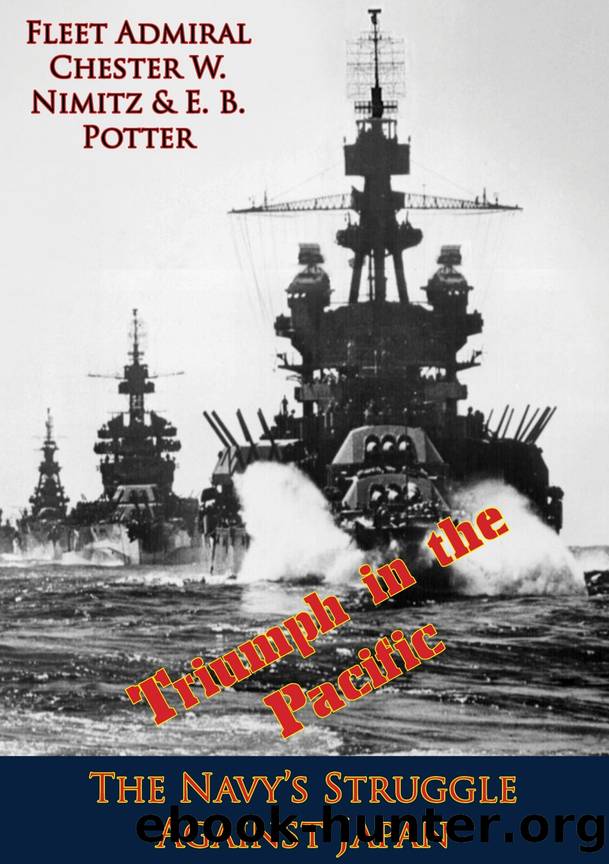Triumph in the Pacific; the Navy's Struggle Against Japan by E. B. Potter

Author:E. B. Potter
Language: eng
Format: epub
Publisher: Pickle Partners Publishing
Published: 2016-07-21T16:00:00+00:00
THE INVASION OF LEYTE
The main elements of the Leyte attack forces sortied from Manus and Hollandia in several echelons between October 10 and 15. On the 17th and 18th the advance units put Rangers ashore on the islands guarding the entrance to Leyte Gulf in order to secure the flanks of the oncoming invasion forces. On the 18th, minesweepers and underwater demolition teams began their important preparatory work off the Leyte beachheads, while fire support ships and escort carriers came in for a two-day pounding of Japanese coastal defenses.
In the early hours of October 20, the transports entered the Gulf and steamed to position for the assaultâthose of Admiral Barbeyâs Seventh Amphibious Force off Tacloban, capital of Leyte; those of Admiral Wilkinsonâs Third Amphibious Force off Dulag, 17 miles south of Tacloban. At the same time one regimental combat team was lifted down to Panaon Island to seize a base whence PT boats could patrol the southern entrance to Surigao Strait, gateway into Leyte Gulf from the south. After a final bombardment of the shoreline, troops headed for the marshy beaches in a variety of craft, including amtracs, which had been loaded in Third Amphibious Force LSTâs for the canceled invasion of reef-surrounded Yap.
Conforming to their new defense doctrine, most of the Japanese retreated to prepared positions in the hilly interior, leaving behind only enough troops to harass and delay the landings. The Japanese at the beachheads caused some casualties with rifle, machine gun, mortar, and artillery fire. A single torpedo plane, attacking in the late afternoon, heavily damaged the light cruiser Honolulu. Compared to most invasions in the Pacific, however, the landings on Leyte were easy. By sunset on the 20th more than 60,000 assault troops and more than 100,000 tons of supplies and equipment were ashore, both Leyte beachheads had expanded more than a mile inland, and the Tacloban airstrip was in American hands.
A few hours after the first landings on Leyte, General MacArthur came ashore accompanied by Sergio Osmena, President of the Philippines. Stepping up to a signal corps microphone, the General broadcast his speech of liberation for all Filipinos to hear: âThis is the Voice of Freedom, General MacArthur speaking. People of the Philippines! I have returned. By the grace of Almighty God our forces stand again on Philippine soilâsoil consecrated in the blood of our two peoples...Rally to me. Let the indomitable spirit of Bataan and Corregidor lead on. As the lines of battle roll forward to bring you within the zone of operations, rise and strike. Strike at every favorable opportunity. For your homes and hearths, strike! For future generations of your sons and daughters, strike! In the name of your sacred dead, strike!â
Download
This site does not store any files on its server. We only index and link to content provided by other sites. Please contact the content providers to delete copyright contents if any and email us, we'll remove relevant links or contents immediately.
| Africa | Americas |
| Arctic & Antarctica | Asia |
| Australia & Oceania | Europe |
| Middle East | Russia |
| United States | World |
| Ancient Civilizations | Military |
| Historical Study & Educational Resources |
The Light of Days by Judy Batalion(829)
Stalin's War: A New History of World War II by Sean McMeekin(689)
Walk in My Combat Boots by James Patterson(614)
The Pacific War 1941-1943 by James Holland(612)
Victory's Price (Star Wars) by Alexander Freed(581)
The Vietnam War: An Intimate History by Geoffrey C. Ward & Ken Burns(570)
First Platoon: A Story of Modern War in the Age of Identity Dominance by Annie Jacobsen(566)
The American War in Afghanistan by Carter Malkasian(559)
Cold War (Alexander King Book 2) by Bradley Wright(558)
Operation Pedestal by Max Hastings(544)
Blood and Ruins: The Great Imperial War, 1931-1945 by Richard Overy(531)
The Madman Theory by Jim Sciutto(523)
Concepts of Space by Jammer Max;(520)
Extreme Fitness by Chris McNab(516)
World War II Infantry Fire Support Tactics by Gordon L. Rottman(504)
Flying Tiger by Samson Jack(501)
Pathfinders by AL-KHALILI JIM(497)
Panzerkrieg by Mike Syron(490)
Hitler’s Pre-Emptive War: The Battle for Norway, 1940 by Henrik O. Lunde(484)
